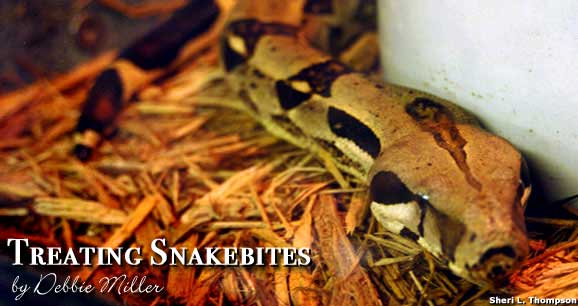| Two men were hiking through the forest. A rattlesnake bit one man on his posterior. The men knew enough to keep the snakebite victim as still as possible while help was sought. The other man ran back to the trailhead to ask for help. Finding park rangers, he told them of the problem.
The park rangers explained that they were working on a heart attack victim, and that the man should return to his friend and perform a simple procedure until help arrived. He would need to make a small incision across the snakebite on his friend’s posterior and suck out the venom, or his friend would die.
Returning to his bottom-bitten friend, he explained that help would not arrive for some time. The injured man asked what the park rangers said. His friend paused, then told his friend, “He said you were gonna’ die.”
While this story is funny, the advice is outdated. In this article we will review ways to avoid snakebites and the latest first-aid advice.
The thought of encountering a snake instills fear in many of us. Yet the chances of being bitten by a snake and injected with venom are quite low for most of us. For example, of the nearly 300 million people in the United States, approximately 7,000 to 8,000 people are bitten each year, and only about five die.
No venom is injected in about 50 percent of the cases of poisonous snakebites. In Australia there are approximately 3,000 snakebites a year, with 200 to 500 of the victims receiving antivenin and one or two fatalities. A snake must have precise timing to bite and inject venom at the same time.
Two common types of venomous snakes are the Viperadae family and the Elapadie family. The Viperadae includes vipers (such as the horned viper or the sand viper) and pit vipers (copperheads, rattlesnakes and cottonmouths). Pit vipers get their name from the small “pit” between their eye and nostril.
The Elapidae family includes coral snakes, mambas, kraits and some cobras. Some non-poisonous snakes mimic the appearances of poisonous snakes. For instance, the scarlet king snake has a similar coloration as the coral snake, and the non-poisonous bull snake looks and acts like a rattlesnake. This underscores the importance of seeking help for all snakebites.
Treatment of snakebites:
The first thing to remember is not to panic. Keep the victim calm and still. Moving the affected limb will spread the venom through the body faster. The American Red Cross makes the following suggestions:
- Wash the area with soap and water.
- Immobilize the bitten area and keep it lower than the heart.
- Get medical attention.
If unable to get medical attention in 30 minutes, the following are cautiously recommended:
- Wrap a bandage two to four inches above the bite, loose enough to put your finger through. It should not cut off the circulation.
- A suction device (from a snakebite kit, available at hiking supply stores) placed over the bite to draw out the venom may be used. It should be used without making any cuts.
- The World Health Organization further recommends that the victim should lie on his or her side in the recovery position to keep the airway clear if there is vomiting or fainting.
- Bring the snake to medical authorities if able to do so without further harm, and without taking precious time. Be careful transporting the head, as the bite reflex works up to an hour after the snake is dead.
What not to do:
- Do not allow the victim to walk; keep him or her as still as possible.
- Do not put ice packs on the bite.
- Do not cut the wound or cut around it.
- Do not use a tourniquet or tight bandage that cuts off circulation.
- Do not suck the venom out (except with a suction device from a snakebite kit and if unable to reach medical help within 30 minutes).
- Do not put medicines or chemicals into the wound.
- Do not try traditional remedies. Time may be lost.
- Do not give the victim food or drink, unless it will be along time before he or she gets medical care. In this case, give water to prevent dehydration.
Invasive first-aid, such as making incisions, is no longer recommended by health authorities. These invasive procedures can cause harm, and it’s not certain that they change the outcome. The most important thing to remember is to get medical treatment fast.
Medical treatment:
Antivenin is the primary treatment for snakebites. Not all bites need to be treated with antivenin, and antivenin can sometimes cause a reaction that could be life threatening. Each person has to be monitored individually to determine the need for antivenin. Antivenin can reverse the effects of the venom, but it doesn’t necessarily reverse the damage done.
Avoiding snakebites:
- Stay on hiking paths.
- If walking in tall grass, wear thick leather boots and long pants, and use a walking stick to tap the ground ahead of you.
- Do not put your hands or feet in areas that you can’t see.
- If you do encounter a snake, leave it alone.
- Be cautious when climbing rocks.
- If you are a frequent hiker, consider buying a snakebite kit. Do not buy older kits with razors, which recommend cutting the bite. Sawyer puts out the only recommended kit (www.sawyerproducts.com).
|

